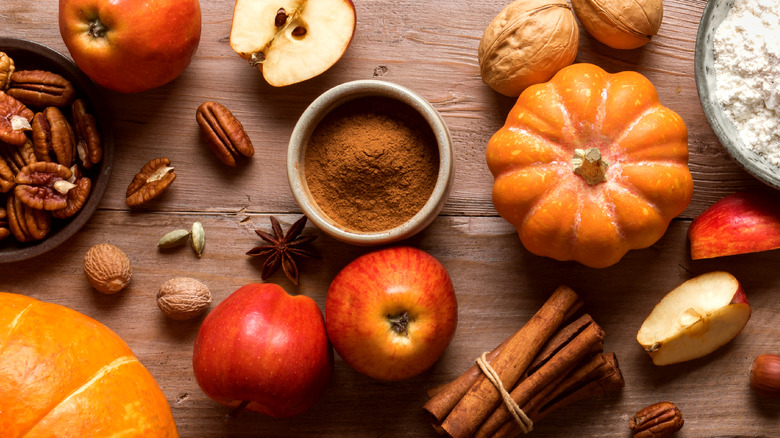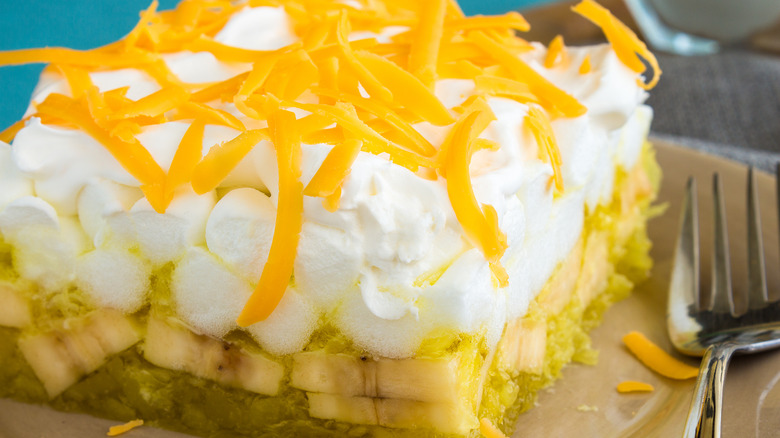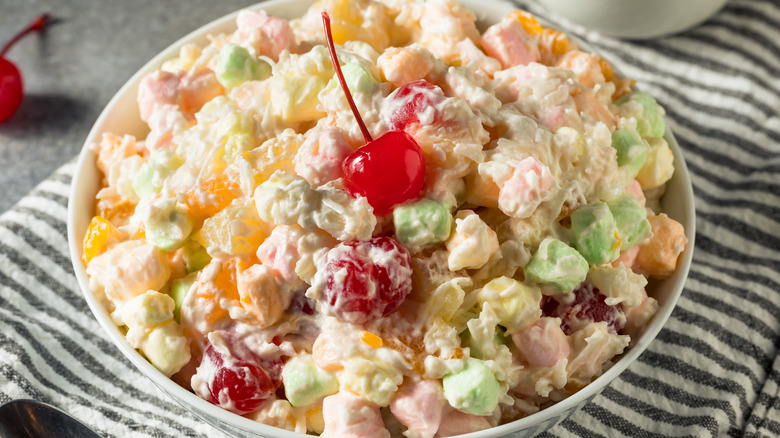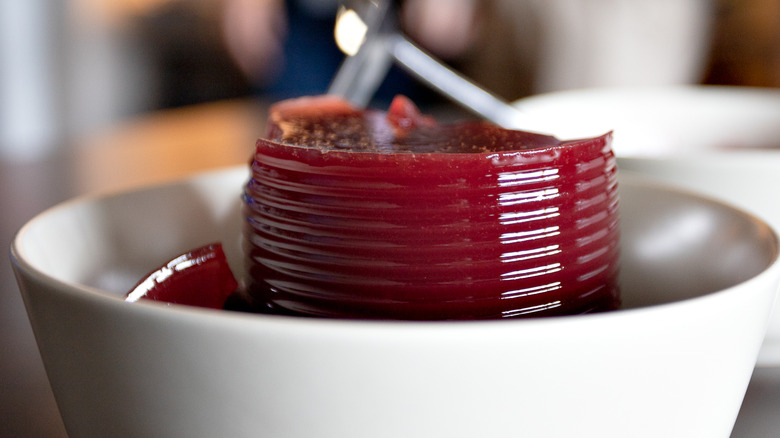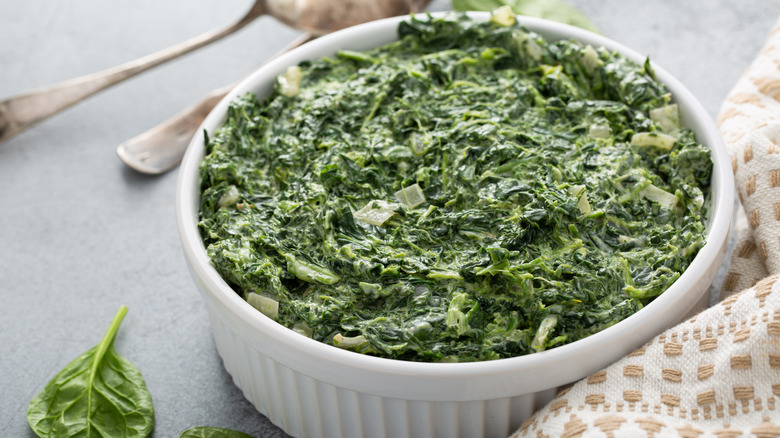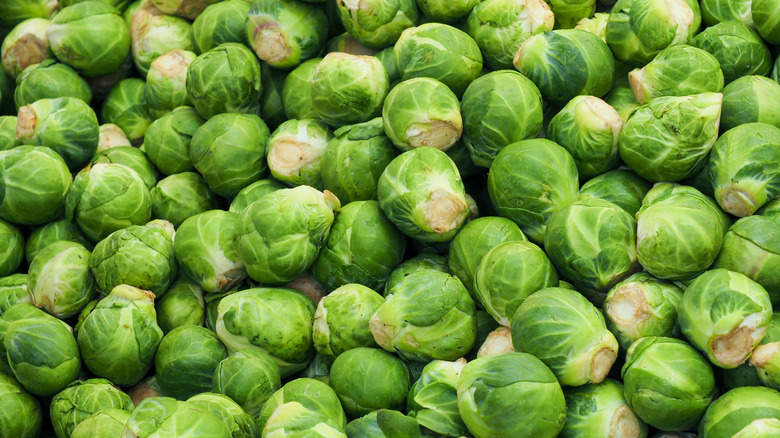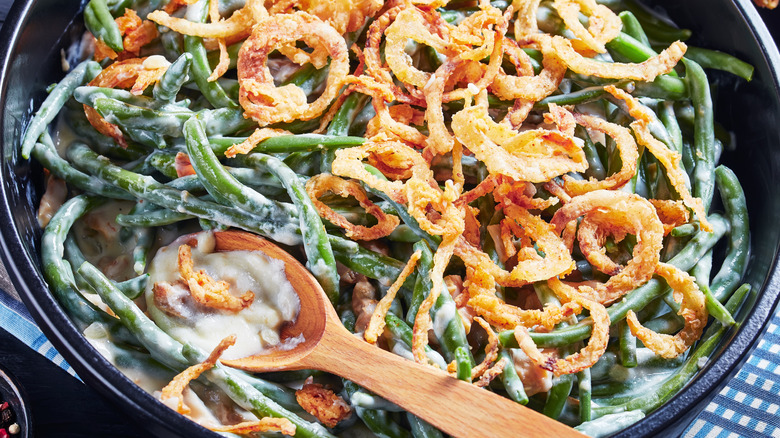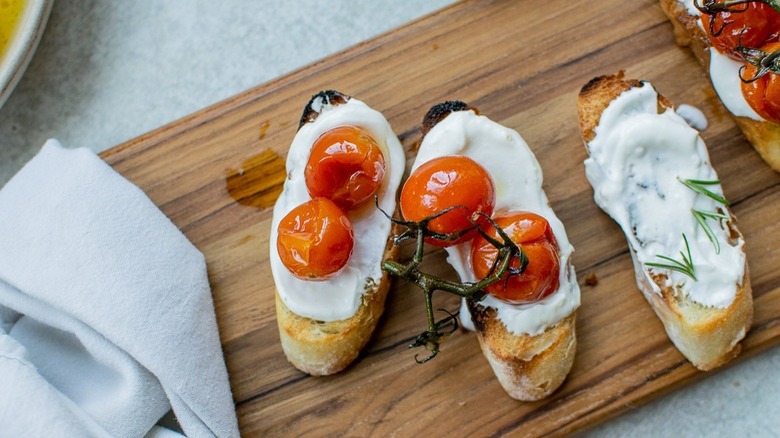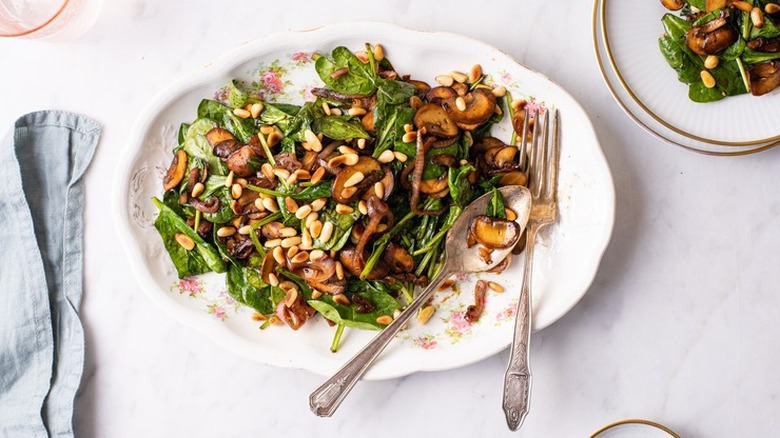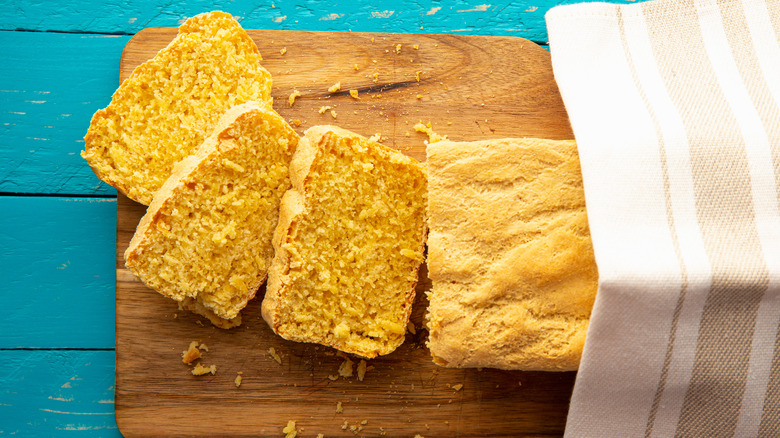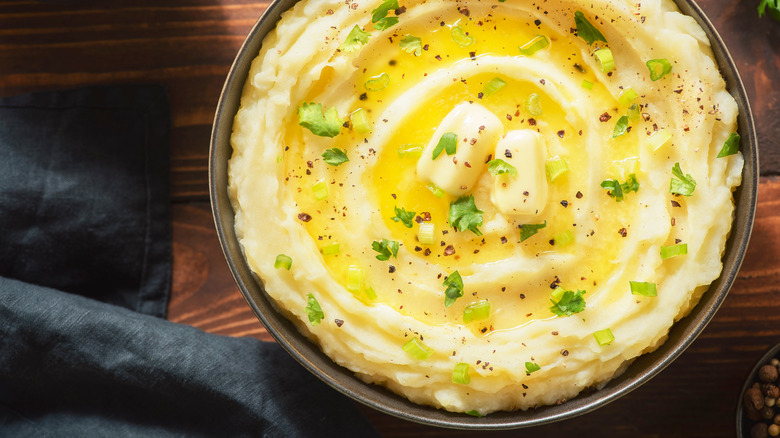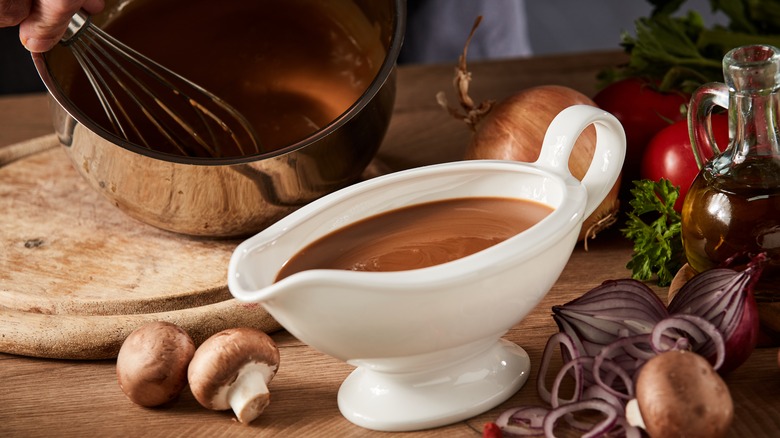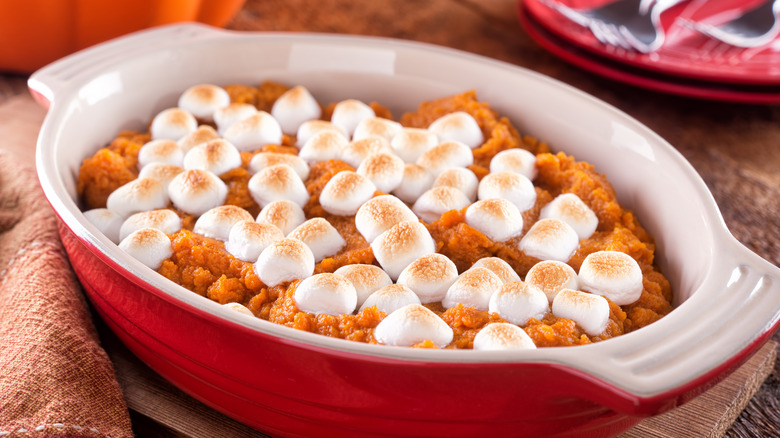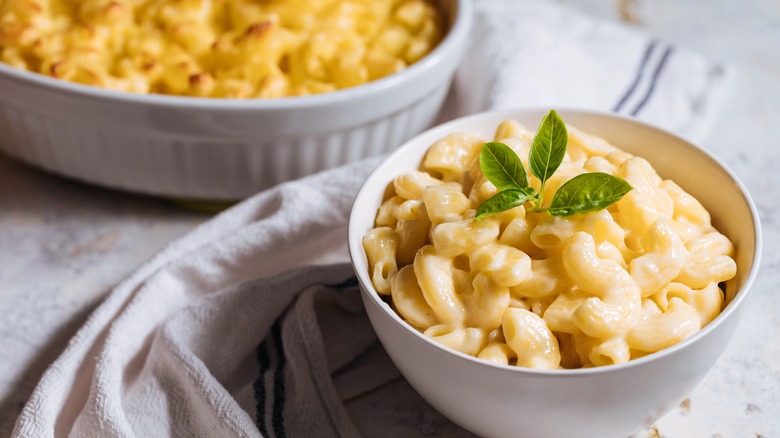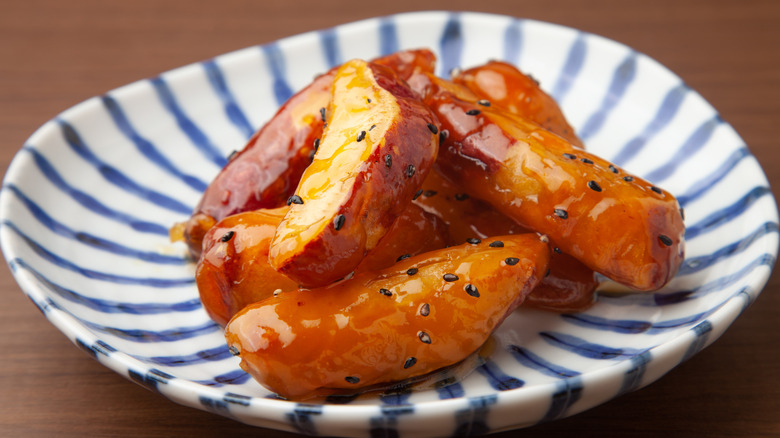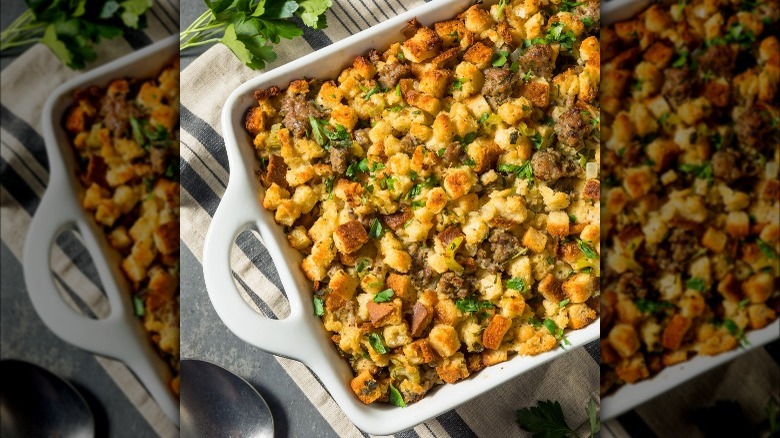Popular Thanksgiving Side Dishes, Ranked From Worst To Best
Thanksgiving is the rare U.S. holiday that derives directly from North American history, for better or worse. As noted by The Fordham Observer, there is perhaps no other holiday that is quite so caked in moral ambiguity. Despite the controversy and conversation surrounding the holiday and the role of colonization in it, there are things worth preserving in the tradition. After all, there is something to be said about sharing a beautiful warm meal with family or friends as fall ends and winter comes in.
It's not as though this holiday hasn't evolved over time. The original Thanksgiving's wild turkey dish wasn't even the centerpiece — it had to share center stage with several other meats. As noted by National Geographic, the food surrounding the feast has greatly changed as time moves on. For a long time, sides were often inspired by New England cuisine like oysters, cranberries, and even at some point ice cream. But as American culture changed and a variety of foods became more widely available, Thanksgiving came to involve a wide variety of dishes from different cultures and regions. Of course, some are much tastier than others. Without further ado, here are 15 Thanksgiving sides to give a chance, or to keep away from, this holiday season.
15. Jello salad
There's no denying it: Jello salad looks straight-up nasty. Recently, it's come into cultural vogue to clown on these once ubiquitous dishes. After all, what about this could possibly be appetizing?
But, despite the jokes, according to the National Museum of American History, jello salads were once well-loved in the American diet. Not only was gelatin an inexpensive meal option, but it was also a means of delivering fresh fruit and vegetables in an (at the time) aesthetically pleasing form. According to the museum, the dish was especially popular during The Great Depression, when food waste was avoided by any means necessary. Jello came to provide, very meaningfully, a method to re-work food scraps.
Despite this noble past, Huffpost argues that there is a very good reason why we feel repulsed by these salads nowadays. The article goes so far as to argue that we are even disgusted on an evolutionary level by the dish. It cites that jello salads hit an unholy trio of gross to our brains: They have a slimy texture, are no longer culturally normalized, and contain unfamiliar elements like suspended meat. But it doesn't take an evolutionary anthropologist to say that the sight of pickled onions in green gelatin is nightmare fuel.
14. Ambrosia
Ambrosia what the food eaten by Greek and Roman gods was called, according to Merriam-Webster. It is a bit ironic that in 2011 NPR claimed that the uniquely sweet Thanksgiving side with the same name spells repulsion for many. At first glance, it seems like ambrosia salad evokes the same horror as jello salad: It's, in some recipes, cream cheese with green jello and Cool Whip with a healthy dose of shredded pineapples and maraschino cherries on top. It looks like a soggy mess and for many, ambrosia is the furthest thing from heaven. But before tossing ambrosia into the shameful hall of disgusting eats, there may be some saving grace to this bowl of mush.
For those who really want to see if this dish can be godlike, there are surefire tips to get you closer to that goal. Our ambrosia recipe calls for not only maraschino cherries and pineapples, but also segmented oranges. This rich and citrusy element cuts through the heavier notes of Thanksgiving dinner while adding a pop of fresh sweetness. In lieu of Cool Whip and green jello, our recipe uses sour cream to keep the dish from being too over-the-top sweet.
13. Canned cranberry sauce
As observed by Real Simple, the tradition of cranberry sauce at the Thanksgiving table has a lot to do with the holiday's place of origin. While cranberries grow well up in New England, they were for a long time a rare delicacy in other parts of the States. It wasn't until the 1940s that canned cranberries came to be and the dish was made widely available. Since then, that gelatinous mess has made it to our tables one way or the other. In a smorgasbord of gourmet goods and well-loved dishes, this slab of red gunk just seems anticlimactic.
It seems like each year around the holidays, a barrage of think pieces come either to defend or criticize this iconically divisive Thanksgiving side. But why should tradition be kept for tradition's sake? After all, isn't the best part of the modern age being able to decide what we do with our sides? In this day and age, fresh (or frozen) cranberries are much more easily found than back in colonial times. Our sweet and tart cranberry sauce recipe is just that: The perfect balance between sweet and sour. It's a lot more nuanced than the often flatly sweet cranberry sauce that comes out of the can.
12. Creamed spinach
Creamed spinach is a side that exists in highs and lows: When it's good, it's great, and when it's bad, it's abysmal. Really, with a little bit of attention, this is a dish that takes on a special shine. The Takeout proclaims that the best, and really only acceptable, form of creamed spinach is a down-home one. The writer sharply advises avoiding unnecessary additions like jalapeños and instead focusing on the comfort side of this comfort food. The perfect creamed spinach is equal parts dairy and spinach, but it should not be soup-like in nature and should be seen as the mashed potatoes of the vegetable section of the Thanksgiving table. Furthermore, creamed spinach should always be served up by the vat. This is not the healthy vegetable on the table.
As our creamed spinach recipe notes, not only is good creamed spinach bold and bright, but it's a team player that works well with so many other dishes. It simultaneously diversifies and harmonizes the feasting table. While frozen spinach is cheap and abundant, as per the recipe, fresh spinach tends to hold a better texture and not develop an oddly slimy texture when mixed with the dairy. To add some notes to this symphony of a treat, our recipe recommends using nutmeg and cayenne pepper for seasoning.
11. Brussels sprouts
Some might disparage brussels sprouts as a boring, basic, or even nasty option. Sadly, it seems that like other phobias and bad habits, our repulsion to brussels sprouts stems from childhood. It doesn't take the work of psychoanalysts to understand why. According to the head of the Brassica Growers Association in an interview with The Telegraph, the last few generations have simply not been cooking the vegetable in the most flattering ways. What this means is that at least in Anglo-Saxon cuisine, brussels sprouts have long been tragically thrown into a boiling pot of water and then served up. This gave the vegetable an unappetizing taste and texture for generations of would-be sprout lovers.
So how does one bring out the best of these budding beauts? The article notes pan frying and steaming as great methods, although roasting will do the trick as well. Really, it seems like a new life has been sprouting up for the once-shunned plant. Horticulturalists point to a change in the culture that's shifting the way this brassica is perceived. The more home chefs and professionals alike experiment, the more people realize that brussels sprouts don't have to be disgusting. For those who have avoided this vegetable like the plague, why not confront a childhood fear this holiday season?
10. Green bean casserole
It's not often that a dish can be traced back to one singular person, but the simultaneously retro and iconic green bean casserole proves to be the exception. In a profile from The Washington Post, the Thanksgiving Day staple for many is credited to one Dorcas Reilly. A prominent member of the Campbell's test kitchen in the '50s, Riley was tasked with creating a spread that any home chef could whip up with canned mushroom soup and green beans. Easier said than done, but Riley didn't shy away from the task.
The original recipe contained only six ingredients and could be prepared and cooked in under 30 minutes. It was a success, and per Smithsonian Magazine, the dish captured the zeitgeist and capabilities of the American kitchen in the '50s. According to the magazine, the prevalence, popularity, and staying power of the recipe shocked even Reilly herself. Nowadays, you don't need Campbell's to get the same effect. Our traditional green bean casserole recipe recommends taking a more home-cooked route and sautéing mushrooms and simmering them in half-and-half and chicken stock in order to get the desired effect. Adding a homemade spin adds richness and depth to the recipe that canned goods don't really hit.
9. Goat cheese crostini
Sure, crostini may seem more like a cocktail snack than a Thanksgiving appetizer, but hear us out. After all, every grand show needs an opening act, and what could be better for that purpose than a lovely bit of fluffy goat cheese delivered on the dream-like crunch of a crostini? It's the perfect balancing act and sure to whet the appetite of expectant guests. Goat cheese is a really solid choice — after all, the Thanksgiving table tends to not really include the cheesy bites we love to nibble on.
What with its sweet tangy taste and often soft texture, goat cheese is a really solid choice to bring to the grown-ups' table this year. While typically health tends to be shoved down to the bottom of the list at the beginning of the feasting season, perhaps we can also do the mental gymnastics to note that goat cheese does have its healthful aspects (via Healthline). For those looking to incorporate leaner treats into their holiday meal, goat cheese proves a surprising, but worthy, option. Also, for food-sensitive friends, goat cheese is significantly lower in lactose content than cow's milk cheese. Really, this is a no-fuss addition that with our goat cheese crostini recipe can be prepped and cooked in a little over 30 minutes.
8. Wilted spinach salad
A salad may sound sacrilegious on one of the most indulgent nights of the year. But, according to Insider, around 31% of American households incorporate some form of green stuff on their holiday table. Really, can't we all stand to have a bit more fiber-rich digestive help on one of the most gastronomically challenging nights of the year? The article cites green salad as the most common Thanksgiving salad, but why skimp on the salad? The best Thanksgiving meals, after all, feature a number of high-quality sides that surround the star of the show.
Wilted spinach may not sound like the most appetizing ingredient, but don't let the name deter you from this seriously delicious dish that's also warm and warming. If your use our wilted spinach salad recipe, this dish comes together quickly, deliciously, and with only a few ingredients that probably are already in your arsenal. The salad only needs spinach, preferably fresh, one shallot, mushrooms, balsamic vinegar, and pine nuts to garnish. The dish comes together in around 15 minutes and is not only fragrant but also very visually appealing.
7. Cornbread
When it comes to food, it may never get more American than cornbread. Somewhat poetically, Discover South Carolina says that the origin of the U.S. and the golden yellow bread are one and the same. As noted by the site, corn was and is a staple crop of the Americas. It existed long before the land was colonized. As Europeans came to stay, maize was worked and reworked in new ways. European colonists in the South who were used to having bread in their diet had corn in abundance, and chances are you can guess the rest of the history.
Even with broader accessibility to wheat, cornbread persists as a simply stunning side dish and comfort food. Corn is always a welcome presence at the Thanksgiving table, and cornbread can offer a pop of flavor that normal dinner rolls may not. Those who are unfamiliar with the Southern delicacy needn't worry, as even the simplest cornbread recipe will yield the most delicious results.
6. Mashed potatoes
Mashed potatoes seem just about as down-home as it gets, but creamy spuds are allegedly French in origin according to Mental Floss. Potatoes were long considered a bad or even poisonous foodstuff in Europe. It wasn't until the 18th century that one French pharmacist sought to normalize the tuber. He came up with many recipes, including mashed potatoes.
It may seem counterintuitive that mashed potatoes arrived to the States by way of Europe given that potatoes originate from South America. But regardless of how or when mashed potatoes got here, it's undeniable that they have come to stay.
The dish may seem like it's fool-proof, after all, it adorns many dinner tables outside of the holiday season. But there are some tips and tricks to make the dish truly outstanding. This traditional mashed potato recipe follows the philosophy that high-quality ingredients will yield the best and yummiest results. So toss those instant mashed potatoes away. As a second piece of advice, the recipe also strongly advises mashing the potatoes by hand so that they have that unique and wonderful chunky mashed potato texture.
5. Gravy
All aboard the gravy train! Gravy is many people's favorite part of Thanksgiving. It adds so much flavor to mashed potatoes and softens the drier cuts of turkey. While it may be a given that gravy is on the table, it wasn't always so easy to come by. As per The Atlantic, once upon a time, gravy was exclusively made by melding meat drippings with starch and water to make a savory, fatty addition to the table. Yum, yum, yum, simply put.
But since the '60s gravy has been a bit easier to make. This is mainly because of the invention of powdered gravy. While some may thumb their noses at the idea of gravy coming from a powder, The Atlantic makes the case that powdered gravy is nothing short of a feat of food engineering. While that's inarguable, there's something to be said about doing things the old-fashioned way. What better to provide some flavorful drippings than a hulking Thanksgiving turkey? A classic roasted turkey gravy ties together all the other Thanksgiving sides.
4. Sweet potato casserole
The sweet potato casserole is, all things considered, a newer addition to the Thanksgiving table. According to Smithsonian Magazine, the casserole has only recently celebrated its hundredth birthday. Despite its relatively young status compared to other dishes, there's just something about sweet potatoes topped with marshmallows that just screams America. Where else are you going to find such an amazing mix of sweet and savory? Not to mention, sweet potatoes come from the Americas originally. While marshmallows may not be American in origin, they certainly are in spirit.
In fact, one specific American company, Angelus Marshmallows, is credited for making marshmallows as mainstream as they are. It sought out the help of prominent American chefs to devise recipes to encourage marshmallow use. It's because of this, for example, that hot chocolate and marshmallows came together for the first time, and the same is for sweet potatoes and marshmallows.
If you're trying to make sweet potato casserole for the first time, use a good recipe. As our sweet potato casserole recipe advises, a sweet potato casserole is only cooked once it hits a rich brown color and begins to bubble. While marshmallows are a classic addition, this recipe calls for pecans to add a little crunch.
3. Macaroni and cheese
Macaroni and cheese is deeply rooted in American cuisine. As noted by Forgotten New England, the ooey gooey wonder dish has a long history at Thanksgiving. The dish started really coming to the table during the 19th century, though it may not have been recognizable to us. Though macaroni back then was still made with the same noodles that we know today, it often involved tomatoes and a layer of grated parmesan.
But, over time the dish came to be cheesier and cheesier and developed into what we know today. It's also important to note that the dish has different meanings for different communities in America. As per The Washington Post, macaroni and cheese is especially meaningful in the Black community, where it can be linked to Southern and Caribbean culture. Macaroni and cheese was also a marker of the advances made by Black Americans because enslaved people did not historically have much access to fancy ingredients like pasta or cheese.
So, when indulging in macaroni and cheese, know that you're continuing on in the long history of a great dish. With so much history and culture, there are a lot of ways to make a great mac. Our creamy homestyle mac and cheese recipe is sure to hit the spot: A rich roux makes sure that the sauce has the right texture, while a breadcrumb crumble adds a nice bit of crunch to the dish.
2. Candied yams
There's some spirited debate as to whether sweet potatoes and yams are really that different. While true yams and sweet potatoes are both vibrant tubers, according to AZ Central, they're not just different vegetables — they're in completely different families. Though as noted by the Carolina-based Coastal Review, confusingly enough, sweet potatoes are often referred to as yams in the States. American candied yams are, in fact, candied sweet potatoes.
So really what differentiates candied yams and other sweet potato dishes, like say, sweet potato casserole, is the preparation and style. While candied yams can also be topped with marshmallows, they're often peeled and served in thick slices, like in our candied yams recipe. Cinnamon, nutmeg, cloves, and ginger add fragrance and lend an incredibly nuanced note to the sweet potatoes.
There are some other things to really elevate candied yams to a rich one-of-a-kind delight, like infusing the dish's butter with bourbon or orange zest. Topping the dish with rosemary will add a wonderful herb element to the entire shebang. In terms of form and versatility, there's nothing compared to candied yams.
1. Stuffing
When it comes to sides, there's nothing better than stuffing. Without a doubt, it's stuffing that ranks among the Thanksgiving sides with the most history. According to Arcadia Publishing, stuffing traces its way all the way back to Ancient Rome. While there's no indication of the role that stuffing played in the original Thanksgiving, by the 19th century at the latest, stuffed birds had come to stay on the American Thanksgiving plate. It's no wonder why this dish has stuck around — it really is the cream of the crop.
It's simultaneously soft, moist, and savory. Likewise, it's one-of-a-kind, and the real side that proclaims: It's Thanksgiving, sit down and dig in. Stuffing is simply the side that needs to be there. It probably depends on where you're from in the States as to what you would define as good stuffing, or even if you would call it stuffing at all. But, regardless if you're making stuffing or dressing, there are still some rookie stuffing mistakes that you want to avoid while trying your hand at this Thanksgiving recipe. If you prepare your stuffing correctly, it's the side dish that people will take seconds (or even thirds) of every Thanksgiving.
